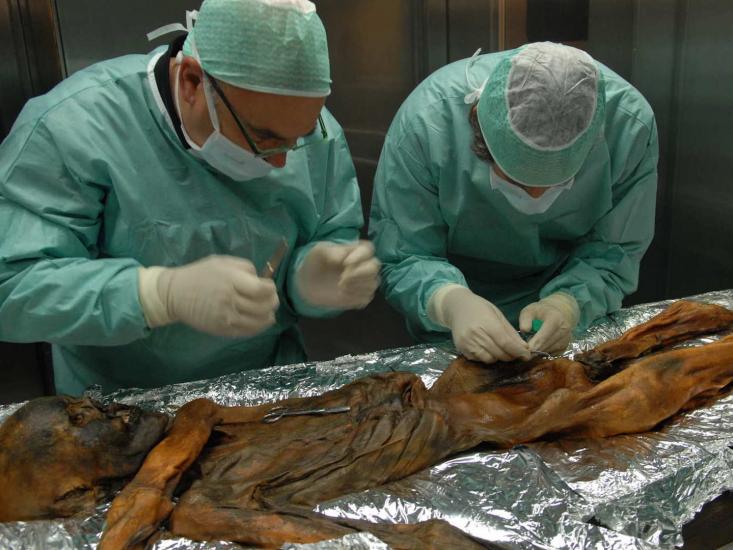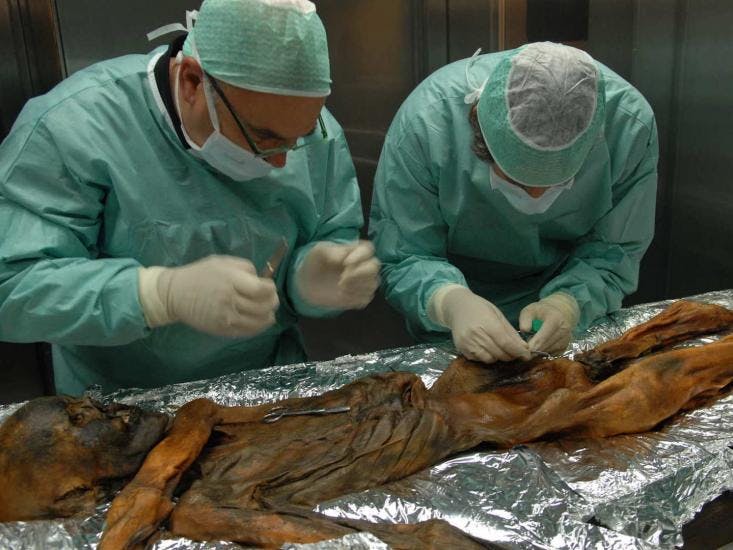
In 1991, two German tourists walking an Alpine ridge, between Austria and Italy, stumbled across something shocking: a yellowed but well preserved human body, partially frozen embedded in a glacier. Initially, they believed it to be the remains of a modern mountaineer but it was actually a member of one of the first agricultural societies in Europe. Ötzi, or “Iceman,” as he was dubbed, was dated to be 5,300 years old.
After sequencing his genome, scientists confirmed that he belonged to a group of Neolithic farmers that were, 8,000 years ago, the first to migrate from the Near East to Europe. This ancient migration now accounts for about 50-60 percent of the modern European genome. As the world’s oldest natural mummy, the Iceman offers a unique glimpse of that migration—and the history of human development in Europe.
But the Iceman’s revelations into human migration don’t stop there. In the Iceman’s stomach, an international team of scientists found a bacterium called Helicobacter pylori (H. pylori), which has been associated with its human hosts, its only viable habitat, for 100,000 years. It is generally benign but can cause stomach ulcers and even cancer. In a report published this week in Science, they unveiled its genome and, by matching it with modern strains of the pathogen, the team found that the Iceman may not only have been feeling sick, but that he also had a strain found only in Central and South Asia.
Human DNA is always going to offer a more precise picture of the space and time in which an individual lived, but the genomes of our microbiota can provide an extra layer of detail. If the Iceman was the typical early European, then it would be reasonable to assume that he would have a strain of H. pylori directly related to that of modern Europeans. Europeans today tend to have a strain called hpEurope, thought to be a hybridized version of the predominant strains found in North East Africa and Central Asia. Although the Iceman has the Asian strain, his H. pylori showed little evidence of any mixing with African strains. That means that the African strains that gave us the predominant European H. pylori must have arrived after the Iceman, not before, as previously assumed.
Scientists used to think hpEurope probably evolved after the last Ice Age, arriving alongside a major wave of migration into Europe from Eurasia. But now, says Yoshan Moodley, of the University of Venda in South Africa, a co-author of the report, “We can say that the waves of migration that brought the African fecal factor pylori to Europe had not occurred—or had not occurred in earnest—by the time the Iceman was alive.”
This finding, says co-author Albert Zink, director of the Institute for Mummies and the Iceman at EURAC Research, doesn’t contradict but refines the conventional hypothesis that humans migrated en masse from Africa to Europe about 60,000 years ago. “In more recent population genetics studies,” he tells me, “we are realizing that there were many waves of migration into Europe, not one or two waves.”
Then again, the Iceman’s H. pylori may just be the consequence of coming into direct contact with one or two individuals, by kissing, say. Think of it like this: The strain of HIV that infects humans managed to spread out of Africa without a concurrent mass migration of people from Africa. Theoretically, the same is possible with H. pylori, says Johannes Krause, the director of the Max Planck Institute for the Science of Human History. Bacteria can travel far faster than a group of humans, even though the two often go hand-in-hand.
Other data can help to confirm an interpretation of the new data. For example, further genomic analysis of other skeletal remains found in Europe, dating to a similar time period, could carry other hallmarks of migration, including pathogens that live in the blood stream. These could then be sequenced, potentially uncovering not only how the Iceman came to have the Asian H. pylori, but also when the African strain of the pathogen that makes up the hybrid found now throughout Europe made its move into the continent.
Another avenue that Zink and his colleagues are keen to pursue is to use comparative data from other mummies from around the world. Scientists in South Korea and South America are now beginning to look at performing similar analyses on their own mummies, many of which also have soft tissues preserved. One area that is particularly intriguing, says Moodley, is whether or not they might be able to trace the spread of H. pylori in North America, as they know that the bacterium could not have existed there prior to the first people crossing the Bering Strait, about 17,000 to 20,000 years ago.
After all, “wherever humans go they take their diseases,” says Trueda.
Claire Cameron is Nautilus’ social media & news editor. @clarabell8



